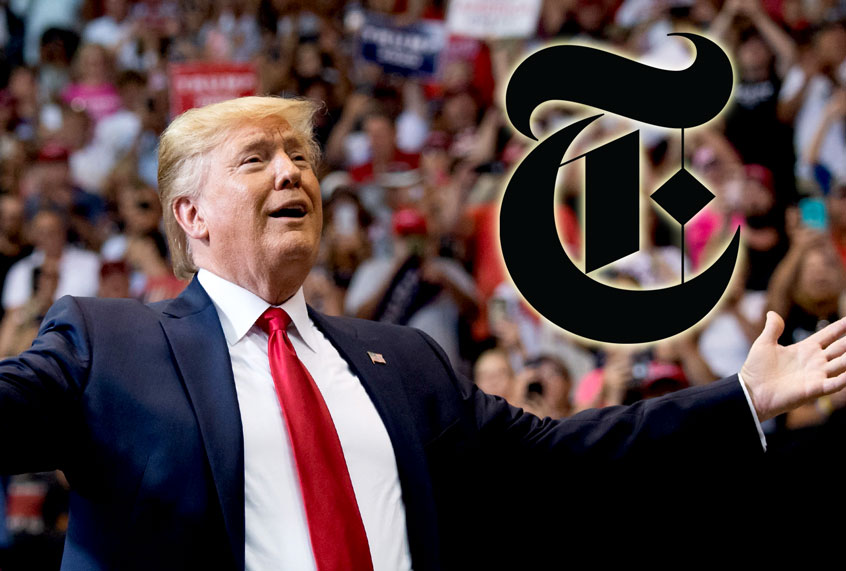Mainstream journalists finally seem to have acknowledged the direct line of causality between Donald Trump’s delusions and incapacities and the federal government’s disastrous failure to respond to a public health emergency.
But the New York Times is still giving Trump the benefit of the doubt in one major way: By continuing to assume — against all evidence — that he is actually trying to do the right thing.
So the headline Friday over the latest article by Peter Baker and Maggie Haberman reads: “The President as Bystander: Trump Struggles to Unify a Nation on Edge.”
“Struggling” is the Times’s euphemism of choice for what Trump is doing these days.
Annie Karni and Maggie Haberman wrote that throughout Trump’s Wednesday night address, he “struggled to find a middle ground between acknowledging the deepening crisis and diminishing its threat to the country’s future.”
A few days earlier, Baker wrote that Trump “struggles to find the balance between public reassurance and Panglossian dismissiveness.” (Ugh.)
But Trump isn’t actually trying to find a middle ground between anything and anything. He just reacts to stuff — and he’s certainly not making anything close to a sincere effort to unify the country that he’s been ferociously trying to divide ever since he came down that fateful escalator.
When the Times writes “struggling” they should write “failing.” Or even better, “not trying.”
Friday’s headline in particular was highly reminiscent of the infamous, if short-lived “Trump Urges Unity Vs. Racism” New York Times banner headline of Aug. 6, 2019, which treated Trump’s speech after a mass shooting — arguably inspired by his racial divisiveness — as a sincere call for harmony.
The evidence is overwhelming that Trump’s only struggles are against the facts, and his only goal is coming out on top. As far as the coronavirus is concerned, everything he has said and done indicates that he simply wants it to go away, ideally with a “miracle.” He has lost any presumption of credibility or reliability.
Whenever Trump appeals to unity, as he did in his stumbling address on Wednesday night, the proper response is to address that absurdity head on, the way John Dickerson did in the Atlantic last year:
Unity can’t simply be asserted, and it can’t be a veiled demand that the other guy cry uncle. It has to be shown through its component parts: reconciliation, empathy, not immediately questioning your opponent’s motives, and restraining your own impulses.
It’s all so in character
After Hurricane Katrina in 2005, the elite political press corps suddenly started sharing such blistering analyses of the previously coddled George W. Bush that I wrote a column for the Washington Post titled, “Now They Tell Us.”
The whiplash isn’t nearly so bad this time around. But it’s still quite something to see so many reporters writing about how Trump has screwed things up so badly — and how it’s totally in character.
Eli Stokols and Noah Bierman wrote in the Los Angeles Times:
President Trump’s inattention to detail, distaste for experts, need for validation and belief that he can create his own set of alternative facts have been hallmarks of his political rise.
But after three years in which daily headlines about chaos in Washington often have contrasted with a robust market on Wall Street and tranquility in much of the country, the president’s unorthodox approach to his job has suddenly been cast in a harsher light by a spiraling and potentially catastrophic global public health crisis.
Determined to convince the public and the markets that his administration has the threat posed by the new strain of coronavirus under control, Trump’s public statements have more often added to the panic than calmed it.
Jill Colvin and Colleen Long wrote for the Associated Press:
President Donald Trump has turned to a familiar playbook as he tries to grapple with the spiraling coronavirus outbreak, blaming immigrants for the country’s problems and casting the global health pandemic as another case of the U.S. against the world.
It’s him against the world:
Through it all, Trump has declined to align himself with fellow world leaders fighting the same crisis, with no global working group, no teleconferences and no words of brotherhood.
One of the most devastating analyses, ironically, came well into Friday’s Baker and Haberman article with the horrible headline. It paints a picture of a president who has flat-out lost the ability to differentiate between reality and fantasy:
After feeling besieged by enemies for three years, Mr. Trump and some of his advisers view so many issues through the lens of political warfare — assuming that criticism is all about point scoring — that it has become hard to see what is real and what is not, according to people around the president. Even when others with Mr. Trump’s best interests at heart disagree, they find it hard to penetrate what they see as the bubble around him.
All these reporters know how profoundly unsuited Trump is for this task, and that he’s arguably the last person in the world you would want in charge right now.
But you still get august reporters like the Post’s Dan Balz signing off — after properly castigating Trump for his huge fail Wednesday night — with a bromide about how everyone hopes the crisis will pass, and “along with that hope is a desire for the president to provide the leadership the moment demands.”
All about the numbers
One particularly astute analysis on Thursday, by Parker, Josh Dawsey and Yasmeen Abutaleb of the Post, called attention to Trump’s perverse fixation with numbers:
Trump’s obsession with numbers — both publicly and privately — has dominated and shaped the administration’s response to the coronavirus, as advisers and public health experts try to placate a leader who largely views the global pandemic through the political lens of how the statistics reflect on his presidency and hopes for reelection.
He wants market numbers up, and he wants case numbers down. Trump is a man who has measured much of his life in numbers — first wealth, then crowd size and votes, and now unemployment and economic numbers — while saying relatively little about the human suffering caused by the coronavirus crisis.
That focus on numbers may turn out to be absolutely central to this whole story — and Trump’s whole presidency — especially if it turns out that Trump suppressed coronavirus testing on purpose.
So far, the sourcing for that allegation is essentially nonexistent. NPR aired an interview on Thursday with Politico newsletter writer Dan Diamond, in which Diamond said it was his “understanding” that Health and Human Services Secretary Alex Azar “did not push to do aggressive additional testing in recent weeks, and that’s partly because more testing might have led to more cases being discovered of coronavirus outbreak, and the president had made clear — the lower the numbers on coronavirus, the better for the president, the better for his potential re-election this fall.”
The interview went massively viral, and as NYU professor Jay Rosen tweeted Friday morning, reporters should prioritize finding out whether Diamond’s understanding is correct, and provable.
Because even though Trump has survived a multitude of revelations that would literally have destroyed the presidency of any of his predecessors, this one, I think, would end him.
Speaking of struggles
There are some legitimate uses of the word “struggle” when it comes to Trump and coronavirus.
So Rucker, Robert Costa, Parker and Dawsey were on somewhat more solid ground when they wrote the other day in the Post that Trump was “struggling to inspire confidence that his administration could stop the spread of the novel coronavirus.”
Jonathan Lemire‘s devastating analysis for the Associated Press noted that Trump was “struggling for a solution, unable to settle Wall Street and proving particularly vulnerable to a threat that is out of his control.”
And most appropriately, Rucker, Parker and Dawsey wrote after Wednesday night’s debacle that Trump was “struggling to read words on the teleprompter.”


